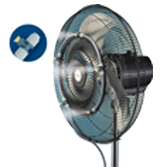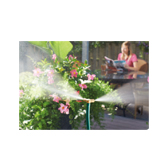Misting Systems 101: Top Functions You Didn’t Know You Needed
A misting system is a versatile tool with functions primarily centered around cooling through evaporative cooling, but also extending to humidity control, air quality improvement, irrigation, and more. Its operation relies on a simple yet effective mechanism: water is pumped at high pressure through specialized nozzles, atomizing it into millions of incredibly fine water droplets, creating a mist or fog.
Here's a breakdown of the key functions of a misting system:
Materials You'll Need:
- Plastic Spray Nozzle: Ensure it's clean and in good working condition.
- Garden Hose or Spray Bottle: Depending on where the plastic spray nozzle is attached.
Evaporative Cooling :
- As the fine water droplets are released into the air, they evaporate very rapidly. This phase transition from liquid to gas requires energy, which is drawn as heat from the surrounding air.
- Temperature Reduction: This absorption of heat significantly lowers the ambient air temperature in the immediate vicinity. The cooling effect is most pronounced in hot, dry climates where evaporation occurs readily.
- Comfort Enhancement: By lowering the temperature, misting systems greatly enhance comfort for people and animals in outdoor spaces (like patios, cafes, event areas), workplaces (industrial settings, agricultural barns), making hot environments more tolerable and enjoyable.
 |
View our products |
Humidity Control :
- By adding water vapor to the air, misting systems effectively increase relative humidity levels.
- Applications: This is crucial in dry climates or specific environments like greenhouses (promoting optimal plant growth and preventing stress), industrial processes (textiles, printing, wood storage), and data centers. Maintaining adequate humidity helps prevent plant dehydration and can reduce static electricity.
Air Quality Improvement:
- Dust Suppression: The fine mist droplets capture airborne dust particles, weighing them down and causing them to settle out of the air. This significantly reduces dust pollution, beneficial on construction sites, mining operations, quarries, and waste management facilities.
- Allergen Reduction: Increased humidity and the particle-capturing effect can help reduce the concentration of airborne allergens like pollen and fine dust.
- Odor Control: Similar to dust suppression, the mist can trap or help neutralize airborne odor molecules. Sometimes, odor neutralizers are added to the water supply for enhanced effect in places like waste transfer stations or livestock farms.
Irrigation,Gentle Watering:
- Misting systems can provide light, even irrigation, particularly suitable for delicate seedlings, certain garden plants, or maintaining moisture across landscapes without heavy watering.
- Efficiency: They can be more water-efficient than some traditional methods as the fine mist minimizes runoff and allows better foliage penetration.
 |
View our products |
Pest Control:
- Natural Deterrent: The movement of air and the presence of moisture can naturally deter some flying insects, like mosquitoes.
- Integrated Solutions: Some systems are designed to incorporate insecticidal or repellent solutions into the mist, providing targeted pest management in outdoor areas with potentially reduced chemical usage compared to broad spraying.
Aesthetics and Special Effects:
Enhancing Ambiance:
- Misting can add a visually pleasing, refreshing element to outdoor dining areas, theme parks, resorts, public spaces, and landscape designs.
- Atmosphere Creation: It's used to create dramatic fog or atmospheric effects for stages, events, or specific architectural features.
Agricultural & Horticultural Benefits:
Greenhouse Climate Control:
- Essential for precisely managing temperature and humidity within greenhouses, creating optimal growing conditions and protecting crops from heat stress, thus improving yields.
- Propagation: Provides ideal high-humidity conditions for rooting cuttings and germinating seeds.
- In summary, while the core function and most common application of a misting system rely on the powerful principle of evaporative cooling to reduce temperature and enhance comfort, its versatility extends to controlling humidity, improving air quality, providing gentle irrigation, managing pests, and creating specific atmospheres. This makes misting systems valuable tools across a wide range of residential, commercial, industrial, and agricultural applications.
